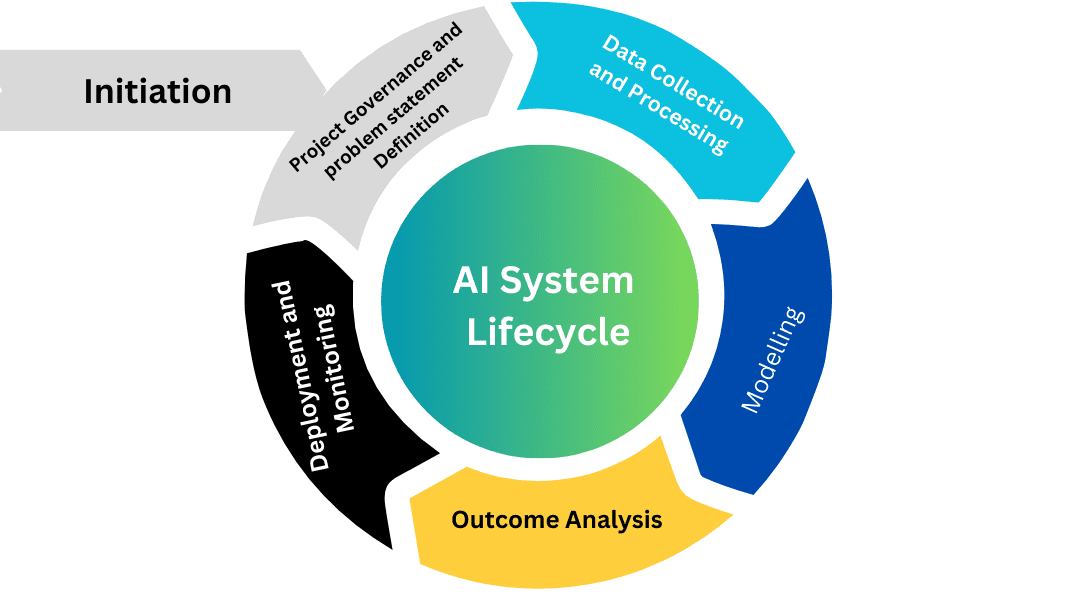Introduction
In an era where artificial intelligence (AI) is reshaping the landscapes of industries across the globe, understanding the AI System Life Cycle becomes paramount for organisations aiming to harness the transformative power of AI. This comprehensive journey from ideation to real-world application encompasses several critical stages, each demanding meticulous attention and strategic planning. Let’s embark on an insightful exploration of these stages, highlighting their significance and offering guidance for navigating them successfully.
1. Project Governance and Problem Statement Definition
The inception of an AI project is not merely about technological deployment but about aligning AI capabilities with strategic business goals. Project governance lays the foundation for a successful AI system, ensuring that the project is aligned with the organisation’s ethical standards, regulatory requirements, and strategic objectives. It involves setting up a framework for decision-making, accountability, and oversight. The problem statement definition, on the other hand, requires a clear articulation of the issue the AI is expected to solve. This stage is crucial for setting a clear direction and ensuring that the project addresses specific, measurable, achievable, relevant, and time-bound (SMART) objectives.
Rob’s Insight: Establishing robust governance frameworks and a well-defined problem statement is akin to setting the compass for your AI journey. It ensures that every step taken is in the right direction, ethically grounded, and aligned with your organisation’s values and goals.
2. Data Collection and Processing
Data is the lifeblood of any AI system. The data collection and processing stage involves gathering the necessary data to train the AI models and ensuring that this data is clean, representative, and devoid of biases. This stage is fraught with challenges, especially regarding data privacy and ethical considerations. It’s imperative to adhere to global data protection laws, to ensure that the data collection processes respect individual privacy and consent.
Rob’s Insight: As we navigate through the complexities of data collection and processing, the mantra ‘quality over quantity’ holds paramount importance. Ensuring data integrity and privacy not only builds trust but also enhances the AI system’s efficacy and fairness.
3. Modeling
Modeling is the stage where data scientists and engineers build and train AI models to perform the defined tasks. This involves selecting appropriate algorithms, setting parameters, and iteratively training the models with the processed data. The choice of model and approach is critical and depends on the problem statement, data characteristics, and desired outcomes. This phase is both an art and a science, requiring deep expertise and creative problem-solving skills.
Rob’s Insight: The modeling stage is where the magic happens, transforming data into actionable insights. However, it’s essential to approach this stage with humility and a readiness to iterate, as AI modeling is often more about learning from failures and adapting than about immediate perfection.
4. Outcome Analysis
Once the models are trained, the next step is to analyse their outcomes critically. This involves evaluating the model’s performance against predefined metrics and real-world expectations. Outcome analysis is not just about assessing accuracy but also about understanding the model’s implications, including potential biases, ethical considerations, and the impact on stakeholders. This stage is crucial for refining the model and ensuring that it aligns with the broader goals and ethical standards set forth in the governance stage.
Rob’s Insight: The outcome analysis phase is a critical checkpoint, ensuring that our AI systems do not merely function but function correctly and ethically. It’s a reflection point to assess not just what AI can do, but what it should do.
5. Deployment and Monitoring
The deployment of an AI system marks its transition from a developmental to an operational phase. However, deployment is not the finish line; it’s the beginning of a new chapter. Monitoring the system in real-world conditions is crucial to ensure its continued effectiveness, reliability, and ethical alignment. This involves ongoing performance evaluation, regular updates, and adaptations to meet evolving requirements and challenges.
Rob’s Insight: Deployment and monitoring underscore the iterative nature of AI development. It’s a commitment to continuous improvement and responsiveness to change, ensuring that AI systems remain effective, ethical, and aligned with our evolving world.
Conclusion
Navigating the AI System Life Cycle is a complex but rewarding journey. It requires a multidisciplinary approach, blending technical expertise with ethical considerations and strategic vision. By understanding and meticulously managing each stage, organisations can unlock the transformative potential of AI, driving innovation and achieving sustainable competitive advantages.
As we continue to explore and innovate within the realm of AI, let us do so with a clear vision, ethical compass, and unwavering commitment to excellence. The future of AI is not just about what technologies we create but how we choose to deploy them for the greater good.

